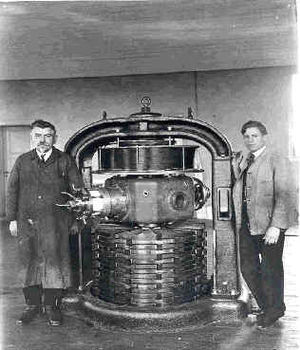Milestones:Poulsen-Arc Radio Transmitter, 1902
Poulsen-Arc Radio Transmitter
Lyngby, Denmark Dedicated May 1994 - IEEE Denmark Section
Valdemar Poulsen, a Danish engineer, invented an arc converter as a generator of continuous-wave radio signals in 1902. Beginning in 1904, Poulsen used the arc for experimental radio transmission from Lyngby to various receiving sites in Denmark and Great Britain. Poulsen-arc transmitters were used internationally until they were superseded by vacuum-tube transmitters.
In the early days of wireless, messages were encoded in dots and dashes and sent by spark transmitters. Conveying voice or music by radio required a continuous-wave (CW) transmitter, and the first successful CW transmitter was the invention of the Danish engineer Valdemar Poulsen. Poulsen was already known for another invention, the Telegraphone, the world's first functional magnetic recorder, patented in 1899.
Poulsen's invention of the arc transmitter built upon the work of the English engineer William Duddell, who had discovered how to make a resonant circuit using a carbon-arc lamp. Duddell's "musical arc" operated at audio frequencies, and Duddell himself concluded that it was impossible to make the arc oscillate at radio frequencies. In 1902, however, Poulsen succeeded in doing just that -- by modifying the electrodes, placing the arc in an atmosphere of hydrocarbon vapor or pure hydrogen, and adding a transverse magnetic field.
Poulsen's transmitter was used worldwide in the second and third decades of the century until it was displaced by transmitters that employed the vacuum tube as a generator of continuous waves.
The milestone plaque is Lyngby, Denmark. If you put "Lyngby" in to Google maps you get a different Lyngby in Denmark, but if you put in "Kongens Lyngby" (a fuller name to distinguish it from other Lyngbys) you get the right one.
<googlemap controls="small" height="250" width="300" zoom="10" lon="12.56928" lat="55.676285" version="0.9">
55.676285, 12.56928,
Poulsen-Arc Radio Transmitter, 1902
Lyngby Radio, Northern Copenhagen, Denmark
</googlemap>
